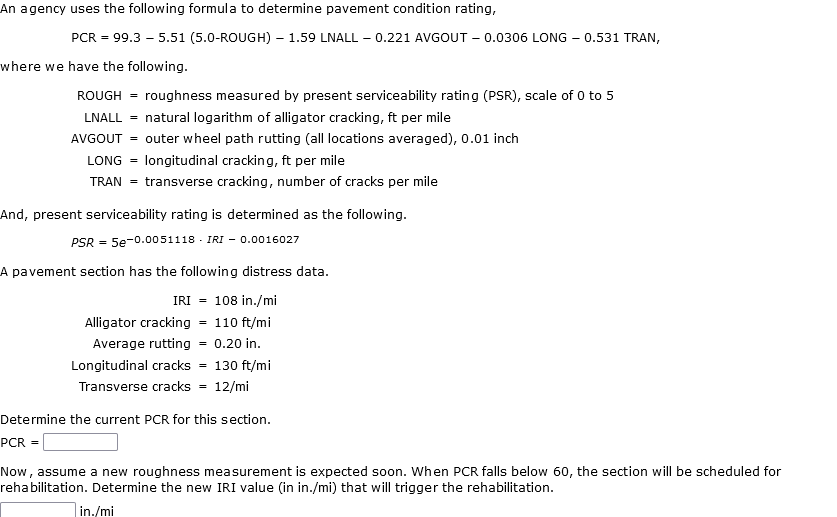Determine the current PCR for this section. PCR Now, assume a new roughness measurement is expected soon. When PCR falls below 60, the section will be scheduled for rehabilitation. Determine the new IRI value (in in./mi) that will trigger the rehabilitation. in./mi
Determine the current PCR for this section. PCR Now, assume a new roughness measurement is expected soon. When PCR falls below 60, the section will be scheduled for rehabilitation. Determine the new IRI value (in in./mi) that will trigger the rehabilitation. in./mi
Traffic and Highway Engineering
5th Edition
ISBN:9781305156241
Author:Garber, Nicholas J.
Publisher:Garber, Nicholas J.
Chapter19: Design Of Flexible Highway Pavements
Section: Chapter Questions
Problem 13P: Repeat Problem 19-7 using two different depths of untreated aggregate bases of 6 in. and 12 in....
Related questions
Question
An agency uses the following formula to determine pavement condition rating,
PCR = 99.3 − 5.51 (5.0-ROUGH) − 1.59 LNALL − 0.221 AVGOUT − 0.0306 LONG − 0.531 TRAN,
where we have the following.
ROUGH = roughness measured by present serviceability rating (PSR), scale of 0 to 5 LNALL = natural logarithm of alligator cracking, ft per mile AVGOUT = outer wheel path rutting (all locations averaged), 0.01 inch LONG = longitudinal cracking, ft per mile TRAN = transverse cracking, number of cracks per mile
And, present serviceability rating is determined as the following.
PSR = 5e−0.0051118 · IRI − 0.0016027
A pavement section has the following distress data.
IRI = 108 in./mi Alligator cracking = 110 ft/mi Average rutting = 0.20 in. Longitudinal cracks = 130 ft/mi Transverse cracks = 12/mi
Determine the current PCR for this section.
PCR =
Now, assume a new roughness measurement is expected soon. When PCR falls below 60, the section will be scheduled for rehabilitation. Determine the new IRI value (in in./mi) that will trigger the rehabilitation.

Transcribed Image Text:An agency uses the following formula to determine pavement condition rating,
PCR = 99.3 - 5.51 (5.0-ROUGH) - 1.59 LNALL - 0.221 AVGOUT -0.0306 LONG - 0.531 TRAN,
where we have the following.
ROUGH = roughness measured by present serviceability rating (PSR), scale of 0 to 5
LNALL = natural logarithm of alligator cracking, ft per mile
AVGOUT = outer wheel path rutting (all locations averaged), 0.01 inch
LONG = longitudinal cracking, ft per mile
TRAN =
transverse cracking, number of cracks per mile
And, present serviceability rating is determined as the following.
PSR = 5e-0.0051118 IRI - 0.0016027
A pavement section has the following distress data.
IRI = 108 in./mi
Alligator cracking = 110 ft/mi
Average rutting = 0.20 in.
Longitudinal cracks = 130 ft/mi
Transverse cracks = 12/mi
Determine the current PCR for this section.
PCR =
Now, assume a new roughness measurement is expected soon. When PCR falls below 60, the section will be scheduled for
rehabilitation. Determine the new IRI value (in in./mi) that will trigger the rehabilitation.
in./mi
Expert Solution
This question has been solved!
Explore an expertly crafted, step-by-step solution for a thorough understanding of key concepts.
This is a popular solution!
Trending now
This is a popular solution!
Step by step
Solved in 4 steps

Knowledge Booster
Learn more about
Need a deep-dive on the concept behind this application? Look no further. Learn more about this topic, civil-engineering and related others by exploring similar questions and additional content below.Recommended textbooks for you

Traffic and Highway Engineering
Civil Engineering
ISBN:
9781305156241
Author:
Garber, Nicholas J.
Publisher:
Cengage Learning

Traffic and Highway Engineering
Civil Engineering
ISBN:
9781305156241
Author:
Garber, Nicholas J.
Publisher:
Cengage Learning